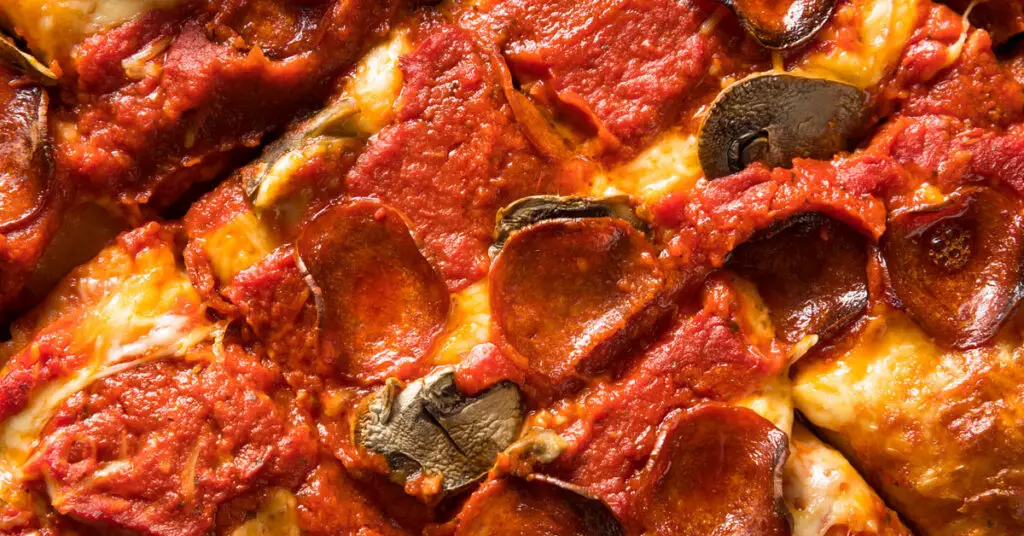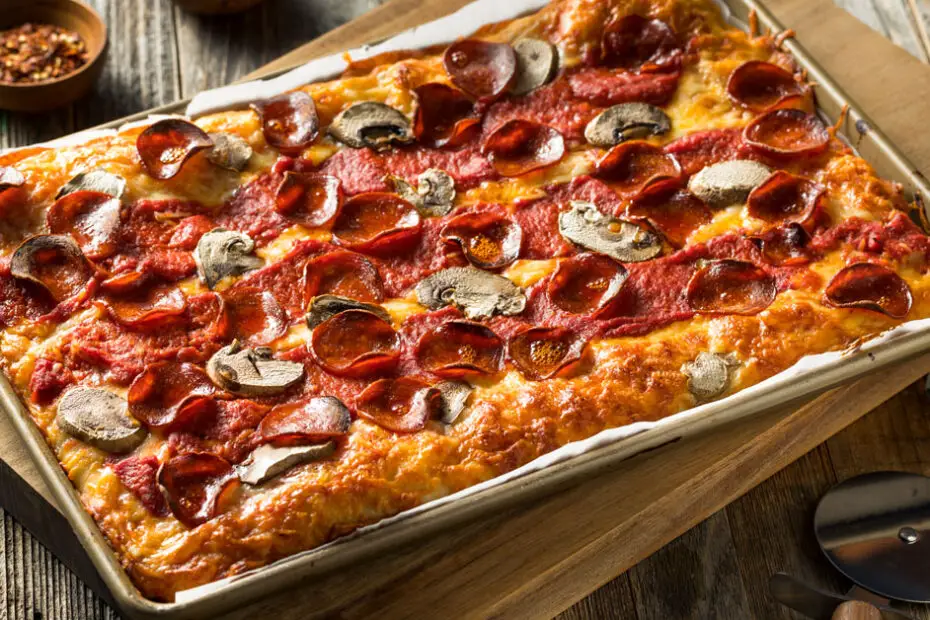If you’re a purist for round pizza, watch out: today we’re all about rectangular pizza!
Don’t knock it before you try it – these straight-edged pies are so delicious, they have the power to convert even the strongest circle believers.
Even though these pizzas might look alike from the outside, all rectangular pizza is not the same!
The two most popular types, Detroit style and Sicilian-style, are actually quite different (although they’re both really tasty). We’ll walk you through everything you need to know, including:
- Key similarities and characteristics
- Key differences when it comes to the dough, toppings, cheese, crust, and more.
Preheated the oven? Let’s get cooking!
Detroit Vs Sicilian Style Pizza: Summary of Key Similarities and Characteristics

People often compare these two pizzas – and for good reason!
There are many features that are similar between Detroit style and Sicilian pizza. This is probably because Detroit-style pizza is based on Sicilian pizza!
Sicilian pizza came to the United States with Italian immigrants in the 19th century, eventually making its way to Detroit where it took on a new style and name.
Key Similarities
It’s true: these two pizza types share some key traits.
Square Or Rectangular Shape
Rectangular is the most common, but you might see some perfect square pizzas out there too!
This leads to different styles of sauce and topping distribution than round pizzas, and to a rectangular slice rather than a triangular one.
Thick Crust
Crust is king in both of these pizza types. There’s usually a higher bread-to-toppings ratio in Detroit and Sicilian pizzas than in thin-crust and even regular American-style pizza.
Baked In A Pan
This allows for the crust to cook evenly, and makes these pizzas easier than most to make at home!
Key Characteristics
Thick, Soft, And Fluffy Dough
Both of these delectable pizzas have similar dough, giving you the perfect bite.
Popularized From Countries/Cities
While you can find these pizzas around the world, they originate from Detroit and Sicily respectively. As such, these regions are where they’re bound to be their best!
Generous Toppings
The rectangular shape and thick dough base mean you can add loads of toppings to these pizzas, without them becoming floppy, soggy, or difficult to eat.
Detroit Vs Sicilian Style Pizza — What’s the Difference?

Even though they have some key similarities and characteristics in common, there’s a big difference between these pizza styles!
Let’s get to the breakdown. Sicilian pizza rose in popularity in the 1800s in Sicily and surrounding regions, being rather different from other Italian pizza styles.
Detroit pizza originated in 1946 at Buddy’s Rendevous in – you guessed it – Detroit! They took a handed-down family Sicilian pizza recipe and gave it their own unique twist.
The Dough
The dough might be the most similar aspect of these two pizza styles.
Both doughs are made using bread flour, yeast, salt, and water. However, Sicilian pizza dough also uses olive oil – making it higher in fat as well as salt content.
This makes it similar (if not identical) to focaccia dough, while Detroit-style pizza dough is closer to traditional American pizza dough (though not exactly the same).
With Sicilian pizza, you’ll also spread the dough in the pan to rise. Meanwhile, you let the dough rise in a ball when it comes to Detroit pizza.
The Toppings
Italian pizza sauce is typically made using fresh San Marzano tomatoes, which are peeled and crushed with salt and olive oil. However, garlic, basil, or other seasonings are sometimes added as well.
American pizza sauce is traditionally cooked and uses canned tomatoes and a variety of seasonings that include garlic (or garlic powder), oregano, red pepper flakes, onion powder, and sugar.
Traditional Sicilian pizza is topped with onions, tomatoes, anchovies, and herbs as well as cheese (though cheese is not always used). The toppings can be distributed uniformly, or in a swirl pattern across the pizza
Detroit-style pizza almost always has cheese – either entirely covering the sauce or in stripes. Familiar American pizza toppings are often used, such as pepperoni, sausage, or hamburger along with veggies.
The Pan You Use In Making The Pizzas
Detroit-style pizzas were originally cooked in steel trays designed for auto shops or factories.
Today, you need a rectangular pan with high, steep sides. Non-stick or anodized aluminum is best for getting your pizza out cleanly.
You’ll need to pour some olive oil into the pans, as well as coat the dough when you stretch it in to prevent sticking and add flavor. You can also use melted butter if you prefer.
Sicilian pizza can be made on a pizza stone but is typically prepared on a baking tray or cookie sheet.
These still have sides but are typically lower than the pans used for Detroit-style pizza.
They should also be coated with a generous amount of olive oil before use. In a pinch, you can use spray or baking paper, but oil is the best and most tasty option.
The Cheese
Sicilian pizza is often made with fresh mozzarella and strong Italian cheeses like toma or pecorino romano. It can also be topped with parmesan.
The cheese is placed evenly across the pizza – not quite to the edges – leaving a distinct bare crust.
Detroit-style pizza is more strict on the cheese; Wisconsin brick cheese is a must if you’re looking for authenticity!
However, mozzarella or American white cheddar is okay if you’re in a pinch. The cubed cheese is distributed across the pizza, including touching the edges of the pan.
Pizza Edges
The edge is what makes Detroit-style pizza so special!
As the pizza cooks, the cheese melts – infusing the dough with a satisfying, buttery flavor.
Then, the cheese on the edges of the pan caramelizes and crisps up as well, leaving an amazing crunchy cheesy edge.
This edge even has its own name: Frisco! It might even look burnt, with some having a dark brown or even black edge, but don’t let it fool you –- it’s addictively delicious.
This attribute can make it hard to eat, however. Sicilian pizza leaves a crust for you to hold onto around the edges, giving you a few bites of bready goodness at the end of your slice.
Depending on the preparation, the edges may be a little more uneven, while Detroit pizza edges will be uniform and quite flat.
The Shape of the Pizza

Due to the different pan shapes, Detroit-style pizzas are often a little smaller, skinnier rectangles with a thicker depth.
Sicilian-style pizzas are bigger, wider, and slightly thinner (though still thicker than most pizzas). They also technically can be circular – but where’s the fun in that?
The slices for both pizzas are typically rectangular. Often, the pies are sliced into six – with one cut down the middle and three going lengthways – giving you even slice sizes.
However, this depends on the size of the pizza, how many people you’re feeding, or just how hungry you are!
What Are The Differences In Crust?
Sicilian pizza has a thick, crunchy-on-the-outside, bready crust. It’s buttery, salty, and even a little flaky – very similar to focaccia bread. It can vary in thickness but needs to have about a two-to-one bread-to-toppings ratio.
Detroit style crust is more porous, with airy sections that make it fluffy and chewy.
It gains butteriness from the fat content in the melting cheese, though some recipes add additional fat to the dough itself as well. Perfect Detroit pizza has a crust that is an inch and a half thick.
Cooking Process
If you’re cooking these pizzas in an oven, it should be set very hot to 550 degrees Fahrenheit (or 220 Celsius) – or as close to that as your oven can get!
Sicilian pizza cooks in around ten minutes, while Detroit-style pizza takes slightly longer to get the caramelized cheese (between twelve to fifteen minutes).
You may want to move both pizzas to the very bottom of the oven halfway through the cooking time to ensure the bottom of the crust crisps up before the toppings overcook.
Sicilian pizza can be served straight out of the pan (carefully), or it can easily be transferred onto a chopping board or large plate.
It takes a little more finesse to remove Detroit-style pizza without losing your perfect cheesy edge. You’ll need to use a thin spatula to loosen the edges and carefully wiggle it out of the pan!
Conclusion
So, which is better: Sicilian or Detroit-style pizza?
At the end of the day, it’s really up to you and your appetite – both pizza types are just so delicious!
If you’re after something lighter – something more like a topped focaccia with fresh, authentic Italian ingredients – you should go for the Sicilian.
If you instead prefer decadent, super cheesy, buttery pizza with the ultimate crispy edge and American-style toppings, it’s definitely the Detroit.
My personal suggestion? Why not both!
As someone from Long Island, New York, Thomas knows what it takes to make a good pizza. He understands that it’s a combination of high-quality ingredients, well-rounded pizza ovens, and a little bit of love. From the dough of a Neapolitan-style pizza to the wood that powers a wood-fired pizza oven, he has you covered. Thomas’ love of pizza is what got him here and he hopes that you’ll enjoy pizza as much as he does soon.
